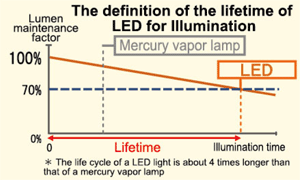Main Features of LED Road/Tunnel Illumination "Amano-Gawa"
Initial Illuminance Adjustment Function
This new function limits excess illuminance at initial installation and realizes a further reduction in power cost.
LED chips are made with glass ceramics that have superior heat radiation factor and resistance to sulfurization discoloration. Because of their resistance to light transmission, LED chips have higher reflectance ratio, higher output power, higher luminosity and prolonged durability.
LED light emitted by the diffuse reflection technology using our unique light reflectors is friendly to our eyes, which leads to improved safety and security.
Conventional light are sensitive to vibration and impact as they use glass tubes. LED lights are highly are impact-resistant to vibration, shock and earthquakes.
In cold climates, LED lights have a long life cycle while conventional lights such as sodium vapor lamps have a shorter life cycle.
LEDs have no flicker since they use direct current.
LED lights do not emit ultra-violet rays,with wavelengths ranging around 350mm, and therefore attract very few insects.
Our technology has been registered with the New Technology Information System(NETIS) established by the Ministry of Land, Infrastructure, Transport and Tourism.
Technology name:LED Road Illumination Fixture "Amano-Gawa Road Light" : Registration No.QS-120031-A
Wider spans are possible with newly-adopted curved toughened glass covers. Light pollution is minimized as no light escapes upwards or backwards.
Our technology has been registered with the New Technology Information System(NETIS) established by the Ministry of Land, Infrastructure, Transport and Tourism.
Technology name:LED Tunnel Illumination Fixture "Amano-Gawa Tunnel Light" : Registration No.QS-1200017-A
The main unit is lighter with a newly-adopted alloy body. The conventional stainless body is also available.
 Conventional light sources my not light up at all if their filaments break. This does not happen with LED lights as they use a solid light emitting system. However, the LED light components gradually degrade with age and the amount of light emitted by an LED decreases in proportion to hours of use. The Japan Luminaries Association has stipulated that the life cycle of white LED lights which are used for ordinary illumination purposes ends when they are down to 70% of their initial total luminous flux. Our "Amano-Gawa" LED lights have heat radiation advantage, resulting in longer product life and less luminous flux attenuation. With less power consumed, LED lights perform as well as mercury vapor lamps or sodium vapor lamps.
Conventional light sources my not light up at all if their filaments break. This does not happen with LED lights as they use a solid light emitting system. However, the LED light components gradually degrade with age and the amount of light emitted by an LED decreases in proportion to hours of use. The Japan Luminaries Association has stipulated that the life cycle of white LED lights which are used for ordinary illumination purposes ends when they are down to 70% of their initial total luminous flux. Our "Amano-Gawa" LED lights have heat radiation advantage, resulting in longer product life and less luminous flux attenuation. With less power consumed, LED lights perform as well as mercury vapor lamps or sodium vapor lamps.◆Comparison with conventional light sources


※Kansai Electric Power Company electric power rate table is used.
※Calculation is dose on 10 units, assuming 4,000-hour use per year for 20 years.





































